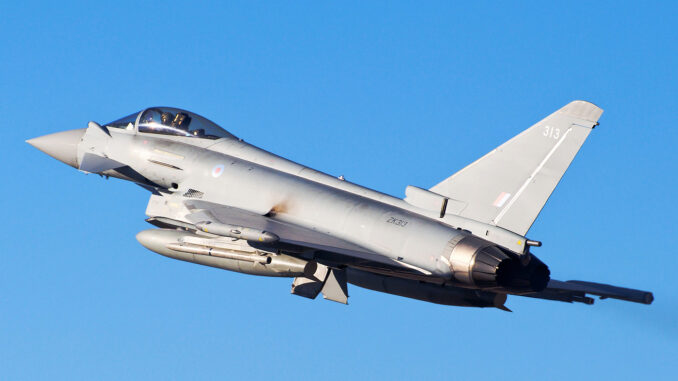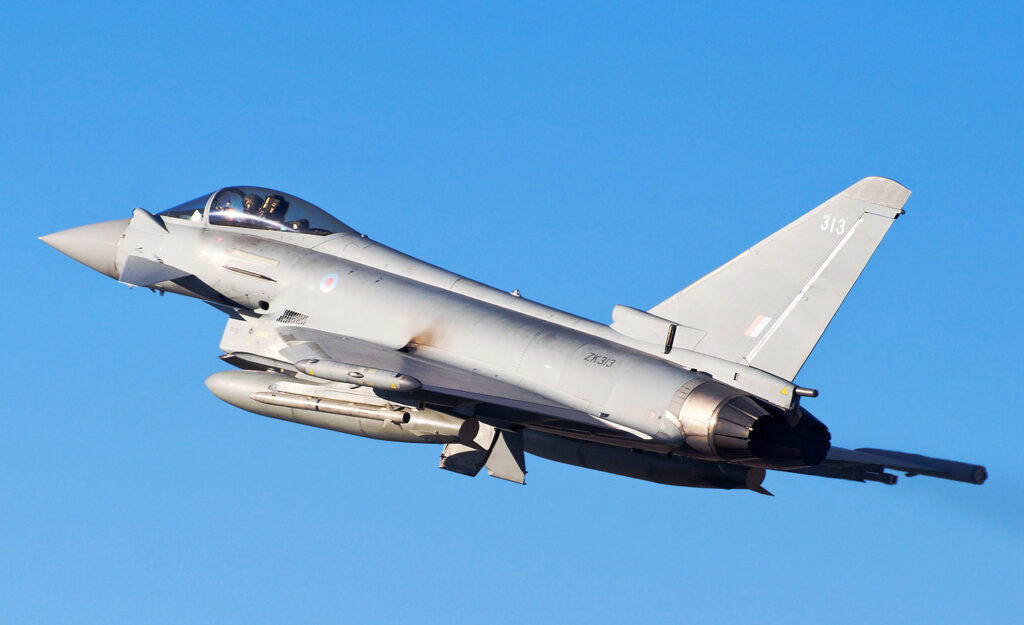
The United Kingdom plans to use the Eurofighter Typhoon until 2040 because of its lower operating costs than the F-35.
The United Kingdom has decided to continue using its fleet of Eurofighter Typhoon until 2040 due to its lower operating costs than the F-35 Lightning II. The Eurofighter Typhoon, in service since 2004, continues to evolve thanks to technological updates, despite its lack of stealth. Its lower maintenance costs than the F-35, combined with its mission effectiveness, justify this decision. On average, the Typhoon costs around $20,000** per flight hour to operate, compared with $30,000** for the F-35.
The Eurofighter Typhoon in the UK’s defence strategy
The Eurofighter Typhoon has been a mainstay of the Royal Air Force (RAF) since it entered service in 2004. This aircraft plays a central role in the UK’s air defence, covering both air superiority and ground attack missions. Designed in collaboration with several European countries, the Typhoon has proved to be a versatile tool, capable of operating in dynamic threat environments.
The fleet of 160 aircraft currently in service is regularly updated to remain competitive in the face of modern threats. Recent improvements include the integration of new weapons systems, such as the Brimstone and Storm Shadow missiles, which enhance its ground strike capabilities. At the same time, the Typhoon’s avionics and radar systems continue to improve, ensuring its relevance on the battlefield until at least 2040.
However, despite its many improvements, the Typhoon has certain limitations, notably the lack of stealth features, which makes it more vulnerable to enemy radar systems and air defences. This raises the question of its effectiveness in environments where stealth has become a crucial factor.
Operating costs: Eurofighter Typhoon vs F-35 Lightning II
One of the main factors behind the UK’s decision to extend the use of the Eurofighter Typhoon is its lower operating cost than that of the F-35 Lightning II. On average, the Eurofighter costs around $20,000** (around €18,800) per flying hour, while the F-35 costs more than $30,000 (around €28,200**). This difference is partly due to the Typhoon’s design, which facilitates access to its critical components, thus simplifying maintenance operations.
The F-35, on the other hand, although benefiting from advanced technologies and stealth capabilities, requires specialised maintenance procedures, which increases maintenance costs. The total cost of ownership of the F-35, including long-term maintenance and repairs, is therefore higher than that of the Typhoon.
Fuel** is another determining factor in the operating cost of a fighter aircraft. The Typhoon, with its powerful engines and aerodynamic design, is more fuel-efficient than the F-35. The latter, which is heavier and has more complex systems, consumes more fuel, which translates into additional costs, particularly for long missions or intensive exercises.

Advantages and disadvantages of the Typhoon in a modern environment
The Eurofighter Typhoon remains a high-performance aircraft, capable of carrying out air superiority and ground attack missions. Its advanced sensor and radar systems, combined with a wide range of munitions, make it a versatile aircraft suited to today’s conflicts. However, the lack of stealth capabilities limits its effectiveness in high-intensity environments, where advanced radar systems can detect and track its movements.
In an environment where furctivity has become a key requirement, non-stealth aircraft such as the Typhoon may be forced to rely on other systems, such as electronic warfare devices or radar jamming aircraft, to safely penetrate enemy defences. This may restrict the aircraft’s tactical possibilities, particularly in missions where the element of surprise is essential.
As a result, the Typhoon could be forced to operate at higher altitudes or adopt secondary roles in combat scenarios where stealth is crucial. Despite this, it remains a reliable solution for missions where air dominance is not challenged by stealth fighters.
Future upgrades to the Eurofighter Typhoon
The UK plans to continue to modernise its Typhoon fleet over the coming years, with planned improvements to the weapon systems, radars and avionics. One of the priorities is the integration of new air-to-ground and air-to-air missiles, to increase the range and accuracy of strikes. The Brimstone missile, already in service, offers precision strike capabilities against moving targets, while the Storm Shadow enables long-range attacks.
Efforts are also focused on improving the on-board sensors, which will enable the Typhoon to better identify and track threats in contested environments. Although these upgrades do not provide stealth capabilities, they will enable the Typhoon to remain competitive against adversaries equipped with more modern systems.
Finally, improvements in the communications and information sharing systems are also planned, with the aim of better integrating the Typhoon into joint operations with other air forces and aircraft, such as the F-35.
Implications for UK military strategy
Keeping the Eurofighter Typhoon in service until 2040 has important strategic implications for the United Kingdom. By extending the life of its fleet, the RAF is choosing to optimise its resources while maintaining a robust air projection capability. However, this decision also shows that the UK has to deal with budgetary constraints, preferring to invest in aircraft whose operating costs are under control rather than turning solely to expensive stealth aircraft such as the F-35.
The UK may also have to review the distribution of its air missions, reserving the use of the F-35 for missions requiring advanced furocity, while using the Typhoon for more conventional operations where this capability is not essential.
War Wings Daily is an independant magazine.